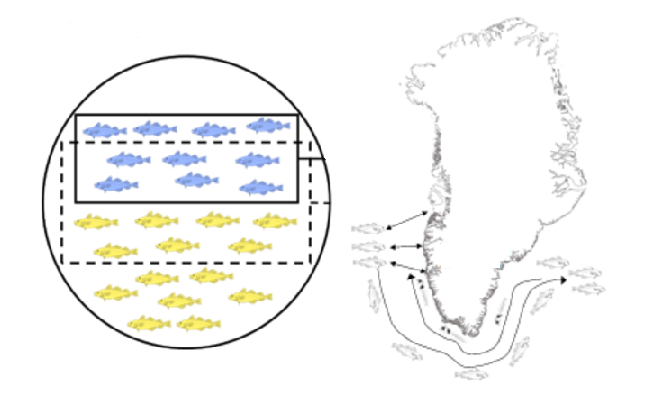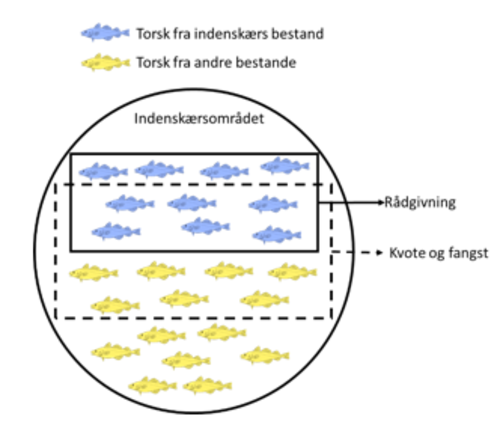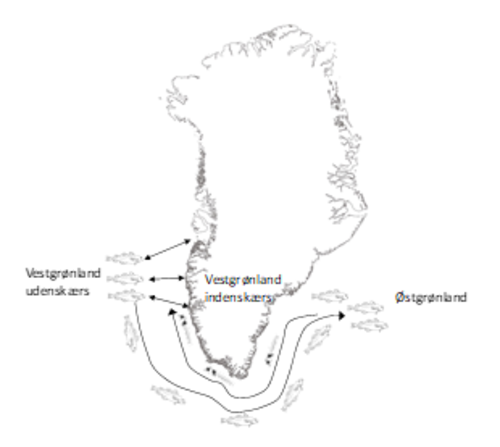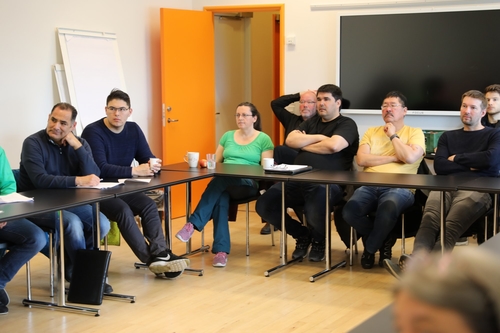New method ensures more accurate advice on inshore cod Published 14.06.2018

The international Council for the Exploration of the Sea (ICES) has given its advice on cod fishery in the Greenlandic waters for 2019. As something new, the advice specifically concerns the inshore cod stock in Greenland, i.e. cod spawned and grown inshore. The advice for this stock in 2019 is 6,806 tonnes. However, inshore fishery also includes other cod stocks that happen to be inshore temporarily. Therefore, the total inshore fishery, including various stocks, can be higher, and the Greenland Institute of Natural Resources assesses that a fishery production of 6,800 tonnes on the inshore cod stock corresponds to a combined fishery production of 14,500 tonnes for the inshore area.

Figure 1. Illustration of the distribution of the different cod stocks in advice, quota and catch respectively. The blue fish illustrate cods from the inshore area, living their entire life in the fjords. The yellow fish illustrate cods from other stocks, which migrate into the fjords, but spawn in other areas. In total the blue and the yellow make up all cod in the inshore area.
“The new method allows us to use all the information we have on stock estimates, catch sizes, age structure, duration of fishery, when the cod is ready to spawn, migration, etc. This has ensured that the advice has become much more accurate. Most importantly, the ICES now advices specifically for the stock that has lived its entire life in the fjords and therefore is more sensitive to the scope of the inshore fishery. The advice is specifically for the inshore stock, not the inshore area, which has been the focus of the advice until this year,” explains senior scientist Rasmus Hedeholm from the Greenland Institute of Natural Resources Department for Fish and Shellfish.
Previously, the advice has been based on two annual studies carried out by the Greenland Institute of Natural Resources. In the new advice ICES has included all available data from the fishery and the Institute´s own studies, and this ensures more accurate advice. As a result, the advice is now categorised in a different category in the ICES system, changing from category 3 (precautionary principle) to category 1 (maximum sustainable yield).

Figure 2. Migration patterns for cod spawned on the banks of East Greenland, Iceland and West Greenland. The East Greenland and Icelandic cods drift as eggs and larvae with the currents from east to west, where they grows. When ready to spawn, they migrate back to the banks in east, where they were spawned. The offshore West Greenland cods migrate into the inshore area, where it lives for a part of its life. When it is ready to spawn, it migrates out to the banks along the Greenland west coast.
The management of cod in the inshore area, however, can easily become a complicated business, as cod in the inshore area comprises of not only one but various cod stocks. Fishery here is a so-called mixed fishery, as it is impossible only to fish the inshore cod. Some cods originate from the so-called inshore stock, and other cods originate from other areas (see figure 1). The various cod stocks use the inshore area while they grow and for seeking food. In other words, the ICES advice only applies to cod from the inshore stock, and not all cod stocks in the area. Based on the available data, the Greenland Institute of Natural Resources estimates that fishery will conform to the advice on the inshore stock, if no more than a total of 14.500 tonnes cod is caught. As the quota in 2018 is 36,500 tonnes, the advice entails a significant reduction of the fishery.
“With the new method we are able to establish that the fishery on the inshore stock is too heavy. If you want to increase the possibility of keeping a healthy stock and ensure a sustainable fishery, the catch sizes must be reduced,” Rasmus Hedeholm concludes.

Some of the fishery stakeholders at the presentation of biological advice for fish species in 2919.

FACTS
Various cod stocks
A fish stock is a group of fish of the same species with the same living conditions, which means, for example, that they were spawned in the same area under the same conditions, and they will themselves spawn in the same area. In Greenland we have at least four cod stocks. Each stock originates from a different area. One stock is the local inshore Greenland cod, which has been spawned and lives its entire life in the West Greenland fjords. Another is the offshore West Greenland cod, which were spawned on the banks along Greenland’s west coast. A third is the East Greenland cod, spawned on the banks of East Greenland. Finally, there is the Icelandic cod. After spawning, a part of the eggs and larvae from the East Greenland and Icelandic stocks drift with the current to the Greenlandic west coast (Figure 2), where they grow. When they reach an age of 5-6 years, they are ready to spawn and migrate back to East Greenland and Iceland. Consequently, all four cod stocks use the inshore area for growth and seeking food.

Rasmus Hedeholm.
For more information, please contact:
Senior scientist Rasmus Hedeholm from Department for Fish and Shellfish at the Greenland Institute of Natural Resources, phone +299 361200 or email: rahe@natur.gl

